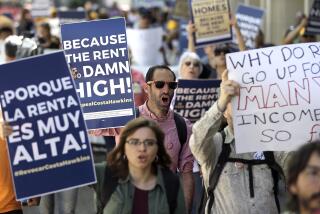Santa Monica Voters May Change City’s Direction : Election: Ballot includes measures dealing with the homeless, rent control and development. ‘There’s a different wind blowing,’ says a retiring councilman.
- Share via
Santa Monica is having an identity crisis.
In Tuesday’s election, there is a strong chance that voters will decide it’s time for the city to be much less hospitable to the homeless. They also may well decide to make a major concession to landlords on rent control. And they may serve notice that the city’s soak-the-developers approach toward financing social services has backfired.
Is the seaside bastion of fire-breathing liberalism taking a lurch to the right?
Most people would say no, it only appears that way. It’s just that this is the 1990s, not the ‘70s. The old coalitions are fraying, the issues are changing--and so is the city.
Nonetheless, this election could change the face of Santa Monica, perhaps as much as the 1979 election, in which voters approved a tough rent control law and a tenants’ coalition, Santa Monicans for Renters’ Rights, grabbed control of the political agenda.
“There’s a different wind blowing,” said retiring City Councilman William H. Jennings. “But then, you never know which way the wind’s blowing in Santa Monica.”
Unlike past years, when rent control was the dominant political topic in the city, crime, particularly that committed by the homeless, and development, especially of hotels along the beach, have emerged as the big issues in this intensely political city.
There is a City Council election with nine candidates vying for three seats, but most of the talk centers on several key ballot issues.
The word “homeless” appears nowhere on the city ballot, but it is the issue underlying Proposition Y, which would make the city attorney an elected official rather than a City Council appointee.
The measure got on the ballot through a petition drive by residents concerned about crime and aggressive panhandling by the city’s large homeless population. It targets Robert M. Myers, the city attorney for the last nine years who has come to personify Santa Monica’s tolerant official attitude toward the homeless.
Myers, a quiet social activist, often declines to prosecute transients accused of nonviolent misdemeanors. On most Saturdays, he can be found doing volunteer work in a program that provides food for the homeless.
Allies praise him as a man of enlightenment and compassion, but Proposition Y backers say he has simply made the city a magnet for freeloaders and troublemakers.
Development is the second hot-button issue in the election. In this case, the broad issue has become inextricably linked with one developer and one project through a coincidence of timing.
The ‘80s brought a building boom to Santa Monica, much of it upscale. The rejuvenated Third Street Promenade now competes with Westwood as a regional destination for moviegoers. Two luxury hotels have opened in the last year, and two more are under construction. And two huge office and commercial projects are going up almost side by side in the eastern part of the city.
Until recently, the consensus among city officials was that such development--if accompanied by steep developer fees-- was a reasonable way of generating money to pay for the city’s extensive array of social services.
That changed last year, when the city attempted to begin development of a large office complex on city property at Santa Monica Municipal Airport. A slow-growth movement developed, with hundreds of residents showing up at planning meetings and City Council sessions to oppose the project. Earlier this year, the council abandoned the project.
But the slow-growth movement had taken root. Two opponents of the airport project are running for the City Council. And the next major project to start through the planning process was the Santa Monica Beach Hotel and Community Center, backed by restaurateur Michael McCarty, owner of the acclaimed Michael’s in Santa Monica. The 160-room hotel is planned on a parcel of state-owned, city-managed beach north of Santa Monica Pier.
In some ways, McCarty’s project is an unlikely symbol of overdevelopment. The proposed facility would be the smallest of the five luxury hotels approved in the last several years. To make the project more attractive to the city, McCarty has planned to include an $11-million community center, which would contain a public beach club, facilities for art and environmental education, a playground, a cafe and an underground parking garage. The project would generate an estimated $3 million a year for the city, according to city planners.
McCarty, moreover, was not some out-of-town corporate developer but a local celebrity, a philanthropist and a supporter of progressive political causes. He had spent years cultivating local support for his hotel.
But timing is everything. In 1990, there is widespread frustration about traffic and pollution, and a growing realization that big development is altering the city’s character. McCarty’s hotel was the only large project actually planned on the beach.
This summer, Assemblyman Tom Hayden (D-Santa Monica), normally aloof from local development issues, blasted the project as an inappropriate use of public land and a symbol of a “Faustian bargain” the city had struck with developers.
In August, the City Council, recognizing the hotel as a hot potato, decided to put it to the voters. To McCarty’s dismay, Hayden has enlisted the Sierra Club and other environmental allies in the Proposition 128 “Big Green” campaign as opponents of the hotel. McCarty, who has invested millions of dollars in the project, has reported spending more than $280,000 on his campaign.
No Santa Monica election would be complete without a fight over rent control.
This year, the big concern is that landlords are fleeing the city after years of frustration at the low financial returns they have been allowed. The average rent for a rent-controlled apartment in Santa Monica is about $500 a month, about half of what it would cost in Los Angeles. Under provisions of a state law called the Ellis Act, landlords have been evicting tenants and quitting the business. City housing officials estimate that about 1,000 of Santa Monica’s 30,000 rental units have been taken out of circulation in the last four years, or are scheduled to be pulled off the market.
Tenants and landlords each have a remedy in the form of ballot propositions. The landlords’ initiative, Proposition U, would remove rent controls from units when tenants vacate voluntarily. The tenants’ measure, Proposition W, would allow some rent increases, but would keep most rents well below free-market rates.
A final election concern involves the length of the ballot. Santa Monica’s is so long that it was impossible to consolidate with the already long state ballot. Voters will have to check in twice on Election Day and cast separate state and city ballots.
More to Read
Sign up for Essential California
The most important California stories and recommendations in your inbox every morning.
You may occasionally receive promotional content from the Los Angeles Times.













